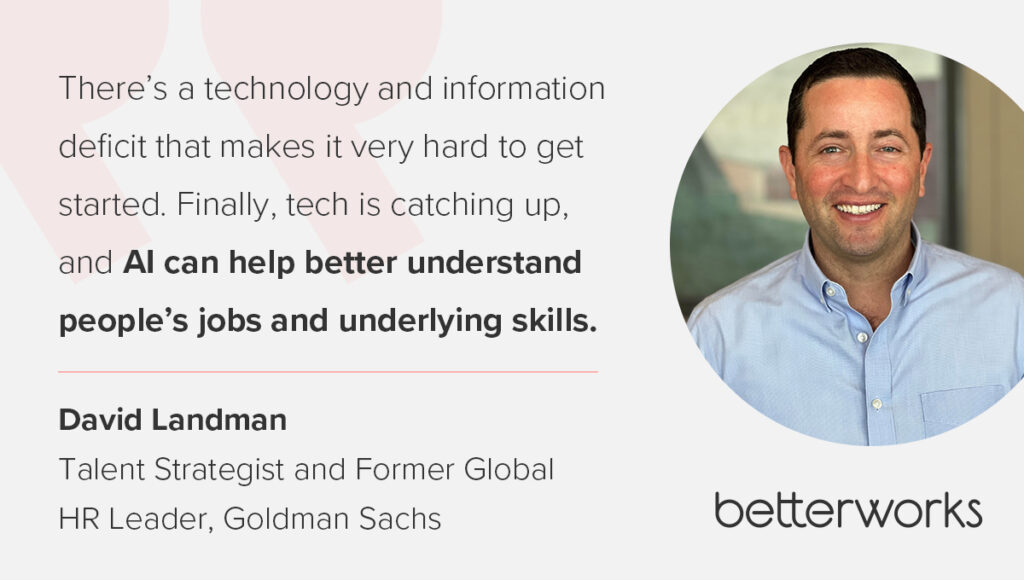HR and business leaders everywhere are waking up to a new reality: Skills are the currency that drives today’s workplace. With talent shortages and markets changing faster than ever, knowing how to tap into your team’s skills isn’t just smart — it’s your competitive edge.
Yet most HR leaders struggle to understand the skills present in their workforce. While 69% of organizations rely on their performance management systems to inform skills data, the performance conversations only happen once or twice per year, according to our 2024 Skills Fitness report. Without current data, you can’t make informed talent decisions.
Traditional approaches and attitudes can hinder your ability to understand and harness the skills within your workforce most effectively. That’s why we invited David Landman, talent strategist and former global HR leader at Goldman Sachs, Ben Eubanks, chief research officer at Lighthouse Research & Advisory, and Jamie Aitken, VP of HR transformation at Betterworks, to participate in our upcoming webinar and panel discussion, “Skills Fitness: Expert Insights in Building a Skills-Based Organization.”
We spoke with David, Ben, and Jamie ahead of the webinar to identify some of the most common barriers to managing skills more strategically, and how to overcome them.
Clinging to outdated ‘best practices’
In many organizations, standard HR practices are holding companies back from taking a more strategic approach to skills. Job descriptions are often static and outdated, failing to reflect the specific skills needed for roles in an evolving workplace. Performance management practices that focus on annual reviews also make it difficult to track and develop skills effectively.
Other traditional tools for understanding skills, like competency frameworks, may not keep up with the pace of change — often taking so long to complete that they outlive their value. This inflexibility makes it hard to accurately assess and leverage employee skills. “It’s static versus dynamic,” Ben says. “It feels so good to have it, but pretty quickly you realize it’s not flexible enough to adapt or keep moving.”
These processes result in a lack of support for employees who want to grow, develop new skills, and explore different career paths.
Lack of centralized access to skills data
A big challenge with building a skills-based company is that you can’t always see what employees are best at. Skills information is scattered across various systems — performance reviews, learning platforms, or even individual managers’ notes — making it difficult to get a complete picture of the skills available within the workforce.
Without a central, accurate data system, it can be challenging to help match the right people with internal opportunities that align with their skills and interests. This results in missed chances for growth and employee frustration.
If you want to understand the state of skills in your workforce, investing in integrated technology solutions is key. “There’s a technology and information deficit that makes it very hard to get started,” David says. “Finally, tech is catching up, and AI can help better understand people’s jobs and underlying skills.” AI-driven skills mapping tools can help centralize skills information through talent profiles, providing a holistic and dynamic view of employee capabilities.
Using technology to track, analyze, and verify skills data provides real-time insights into the skills present in your organization, and can help open conversations with employees about the skills they want to develop.

Outdated mindsets about career progression
Culture is one of the most significant barriers to fostering a skills-based organization. You can update processes and technology, but without changing attitudes, these innovations can still fail. “We need to unleash ourselves from some of these older, more traditional mindsets because I think they actually get in the way of getting to a much more transparent and agile way of looking at skills,” Jamie says.
In many companies, for example, there’s a deep-seated culture of talent hoarding. Managers are reluctant to let top performers move to other roles because they fear losing productivity. This can lead to frustration for employees who feel their growth is stunted by their current team’s need to retain them.
Moreover, traditional career paths often suggest a linear progression — a career “ladder” — which doesn’t align well with today’s job market where skills and roles are constantly changing. This outdated view prevents organizations from fully using the workforce’s cross-functional skills.
Changing culture starts with leadership. Work with executives and managers to help them understand the value of talent mobility, not just for individuals but for the entire organization. Encourage managers to see themselves as talent developers rather than talent owners. One way to do this is to recognize and reward managers who foster mobility and growth within their teams, highlighting those who successfully develop talent that goes on to thrive in other parts of the business.
Finally, change how employees and managers think about growth. Create more flexible career paths where employees can move horizontally, take on temporary assignments, and explore different roles — ultimately building a diverse set of skills that benefits both the individual and the organization.
Want to learn more? Register to attend “Skills Fitness: Expert Insights in Building a Skills-Based Organization.”
Upskill your approach to upskilling









